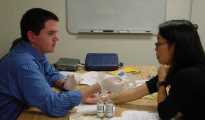Teaching Resident Physicians to Be Educators

Resident Teaching Videos
Resident Teaching Videos: Two Different Teaching Styles
Resident physicians provide a lot of teaching for students and also for fellow residents. For many residents, when they start teaching, they are struggling with developing their own teaching styles. By following the links below, you can see two different one-minute videos. Each video features a resident teaching a student: what varies is the resident's teaching style. In both scenarios, the resident and the student are seeing patients together. The scenarios begin as the student is finishing presenting a patient to the resident.
Discussion questions:
- What specific behaviors did you particularly like in this resident's teaching style?
- What could this resident have improved about her teaching approach?
The resident started by trying to get more of the patient's history through the student. That's not always wrong, but it could have distracted the student from her "teachable moment." You may have noticed, though, that the teaching interaction improved as it went along. When the student asked the resident a question about pregnancy testing, the resident was able to turn the situation into a learning opportunity by asking the student what she knew about the topic herself. This question gave the student a chance to sort through her knowledge base in preparation for further learning.
Discussion questions:
- What was the resident's point in asking the student to explain why she thought the patient had peptic ulcer disease?
- In both scenarios, the resident asked the student questions. How were the questions different in this scenario, compared with those in the other scenario?
- In which scenario did the student appear to learn more?
Here, the resident started by asking the student what she thought was going on with the patient, and then asked the student to explain her underlying clinical reasoning. (The student is probably more likely to remember what she learned because she went through her own thinking process.) The resident then taught clinical pearls, she gave some feedback, and even asked if the student had any questions--all within the space of about one minute.
No teachers are busier than resident teachers, but even so, it is possible to squeeze "teachable moments" into patient care so that we can help students learn efficiently and effectively.
